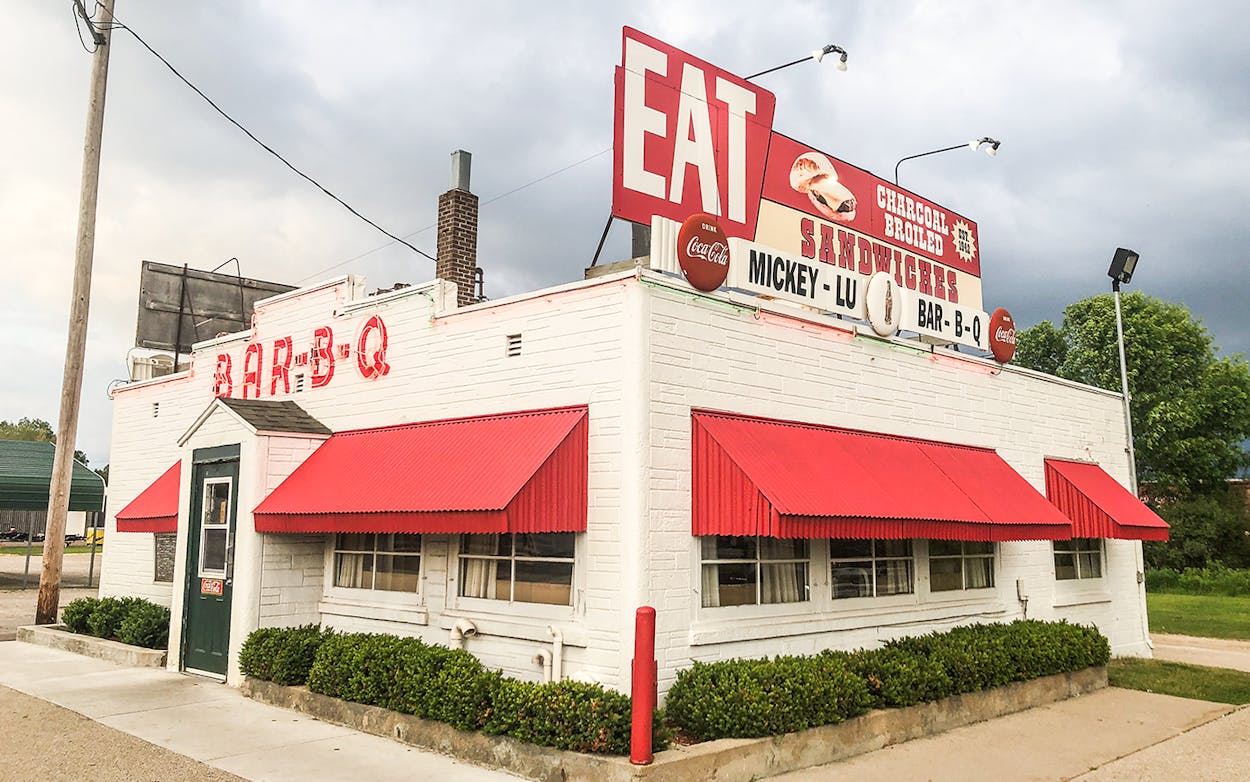A barbecue road trip through the American South is hardly a challenge. Texas, Alabama, Georgia, and the Carolinas are rich in barbecue destinations. This summer I’m taking a different sort of barbecue road trip—from Minneapolis to Toronto and back. There’s plenty of smoked meat stalwarts to explore, but the expansion of barbecue’s popularity outside its traditional boundaries means there’s lots of new blood too. I’ll do my best to chronicle a little of both throughout the adventure.
WISCONSIN
This trek technically begins in St. Paul, Minnesota, just sixteen miles shy of the Wisconsin border. I don’t know which states have White Castle—the chain known for sliders and having only one size of fries—so I was afraid to pass up “BBQ Season,” as advertised on a banner outside one of its St. Paul locations. I expected a slider with barbecue sauce and pickles. They had those for 99 cents, but they also offered a sliced brisket slider for double that. Of course it was terrible, but it speaks to the ubiquity of smoked brisket in these United States. A chain without a presence in Texas used brisket as the de facto meat in its signature sandwich during the generically dubbed “BBQ Season.” Maybe this is brisket officially jumping the shark—or a shift from pork to beef when it comes to what most Americans expect in barbecue.
Driving straight across the heart of Wisconsin, the options for brisket were nonexistent, but multiple billboards advertised smokehouses with sausages, bacon, and jerky. My son and I stopped at one spot familiar to bacon connoisseurs, called Nueske’s in Wittenburg, Wisconsin. Sadly its retail shop had no BLTs, but we found landjaeger sausages, ham, jerky, and some applewood smoked bacon to enjoy later. Crossing the Rib River on the way into Wausau got my hopes up. We could have hiked up Rib Mountain or taken a dip in the Little Rib River in town, but we were too early for the annual Balloon & Rib Fest.
Crossing Wisconsin was the goal for the day. At the far end of the state, along the banks of the Menominee River that constitutes the border between Wisconsin and the Upper Peninsula of Michigan, is the ship-building town of Marinette. Neon lights spelling out “Bar-B-Que” shone brightly above Mickey-Lu Bar-B-Que. The restaurant started on the Michigan side of the river in the 1930s before moving to its current spot in 1942. Smoke drifted from the chimney, but Mickey-Lu’s doesn’t really serve barbecue.
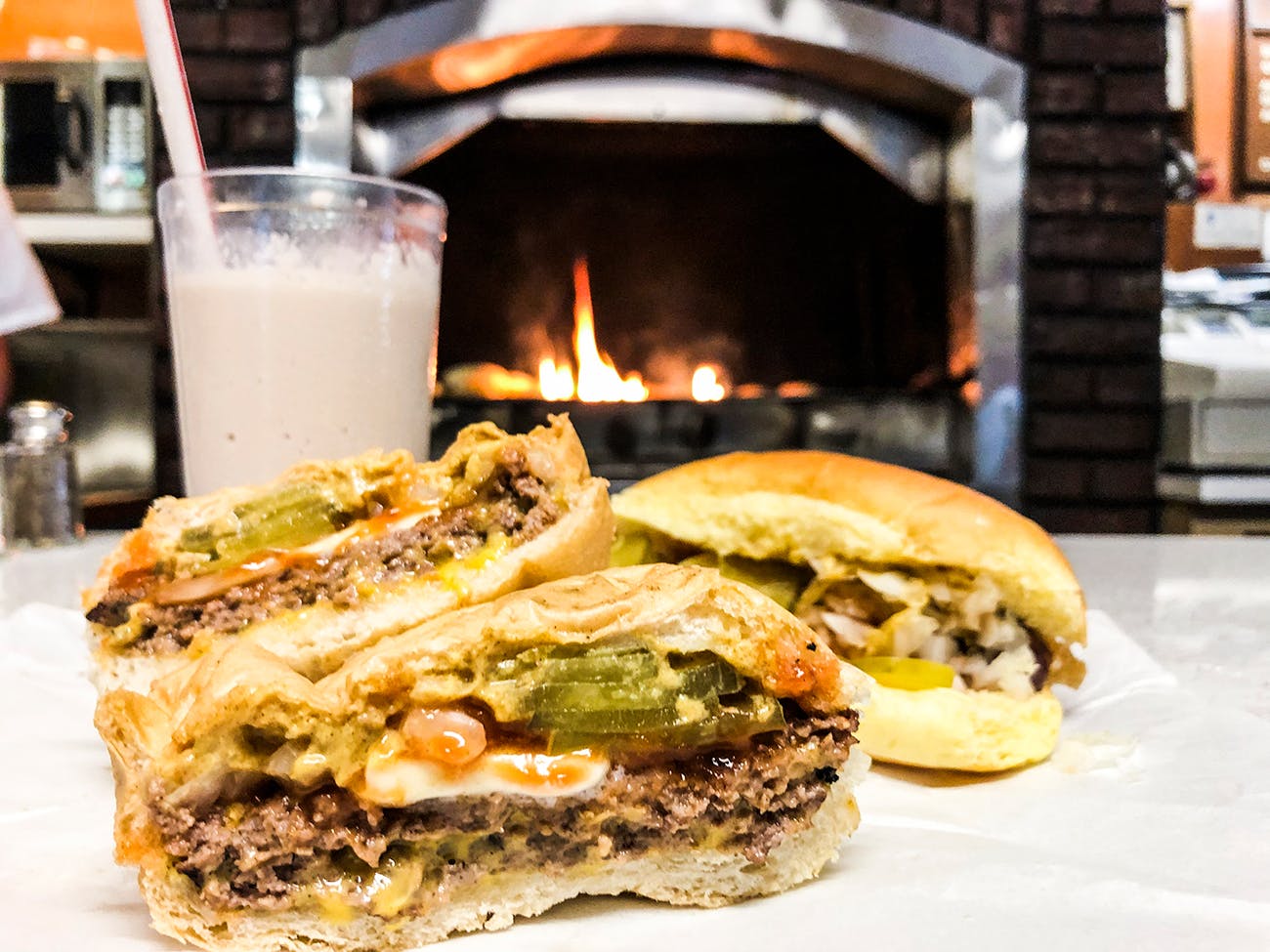
“You know right away from their accent if they’re going to be unhappy,” a woman working the grill told me when I asked if people are disappointed to find a burger joint under that neon sign. She said it happens daily. In Texas, when we discuss other barbecue styles, Wisconsin is often the punchline. Their barbecue is just burgers and brats, we say, and in this case the joke holds up, except that this was an incredible burger.
Only eight patties of beef go on the original charcoal grill at once. They’re paper thin, so most people order the double. The meat is ground in the restaurant every morning. There’s enough fat in the mix that when the patties are flipped on the grill there’s a sustained flame that hurries them along to doneness.
Cut buns surround the beef on the grill. A hearty German “Zemal” roll with a good crust and chew is used. Toppings include ketchup, pickles, finely diced onion, and a spicy mustard. Every burger gets a thick pat of butter added right in the center of the meat before the crown of the bun is put into place. It’s cut in half, revealing the not yet melted butter that makes a great first bite. The burger is what I imagine Burger King once aspired to. It had a deep char-grilled flavor, was plenty juicy despite the incredibly thin patties, and I loved the chewy roll that was also hot off the grill. If this is Wisconsin style barbecue, those punchlines may have been premature.
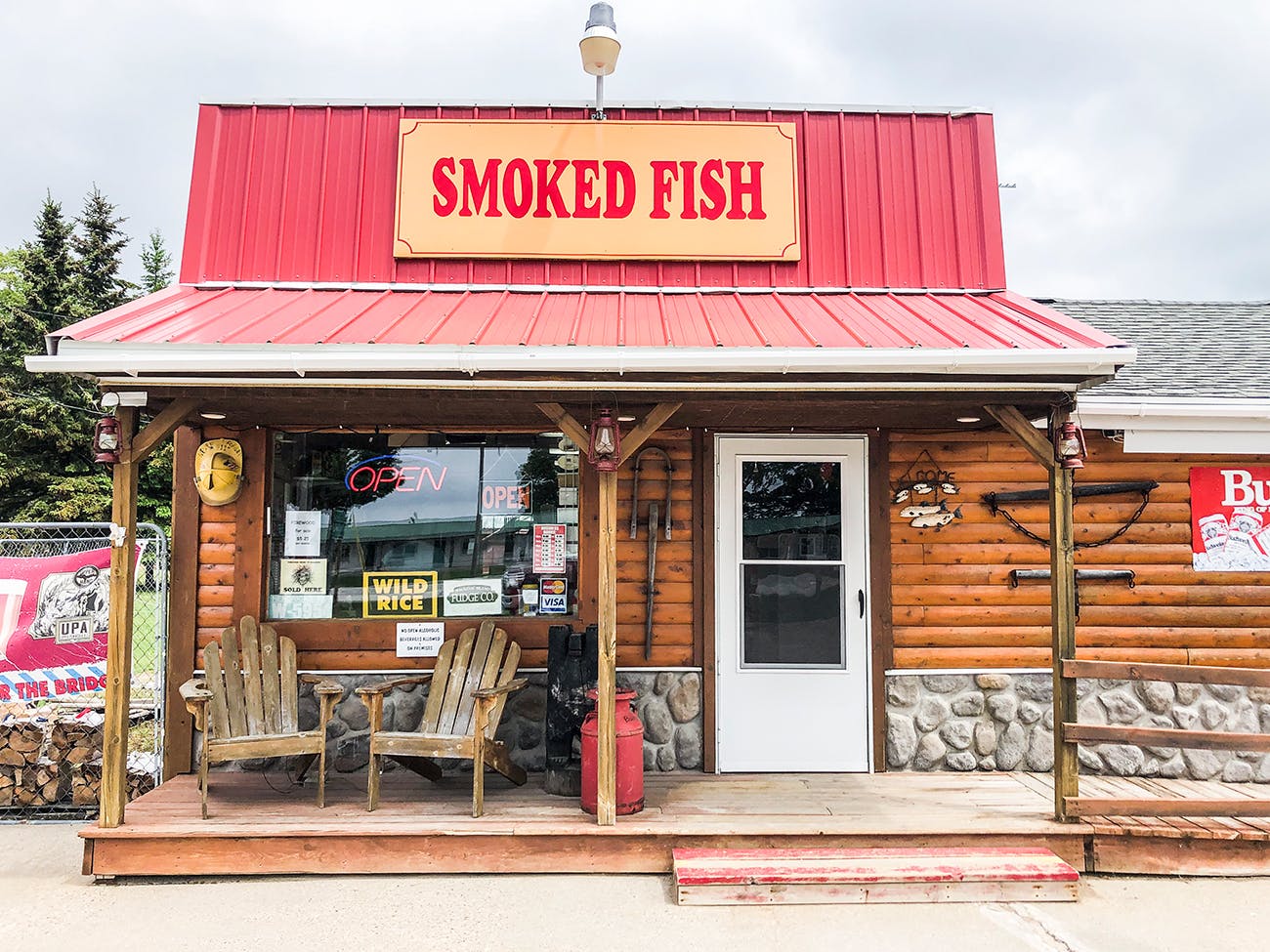
UPPER PENINSULA
A drive through the upper peninsula of Michigan means you’ll see a stop for smoked fish about as often as you’ll find beef jerky being touted in Texas. From Manistique to Mackinaw City along Route 2, which mostly hugs the northern shore of Lake Michigan, just about every dot of a town had one.
Our first stop was at King’s in Naubinway. The thrift store disguised as a souvenir shop had a refrigerated case by the register that held smoked whitefish and lake trout. The woman working the counter said a license—which they didn’t have—was required to smoke and sell fish, so they get their products wholesale from Mackinac Fish Market in St. Ignace. I bought small portions of both and settled in at a picnic table outside.
Smoked fish in the UP is pungent. A tip when trying your first sample is to have wet naps or a strategy for washing your hands afterwards. Napkins won’t get that smell off your fingers. I started with the whitefish, peeling back the skin and lifting a chunk of meat away from the bones. The first bite was smoky, a bit dry, and punishingly salty. I preferred the lake trout. The flesh had a an orange tint and far more fat. The flavor of the fish was stronger, balancing out the smoke and salt more effectively. I knew to look for trout, and a smokehouse on site, from here on out.

The Cut River Store just east of Epoufette offered smoked salmon and rainbow trout along with the standard whitefish and lake trout. Customers like the salmon and rainbow trout because it’s boneless. It’s also twice the price of the stuff from the lake and is farmed out of state. The whitefish here are only available whole and weigh in around two pounds, so I stuck with a chunk of lake trout and took my haul down the road to Brevort for a side-by-side tasting at Gustafson’s.
A pair of small, wooden smokehouses, thoroughly blackened with smoke aside from their bright red doors, stood beside the gas station that Gustafson’s inhabits. The fires were out, but the smell of smoke lingered. I brought a portion of their smoked trout to the hood of the car and tried it compared to the Cut River Store’s. The former was a bit drier, but I enjoyed both. It seemed to this point that most of the smoked fish houses were selling comparable versions of the same stuff. Then I headed north to the shore of Lake Superior.
Brown Fisheries in Paradise has operated its restaurant, the Fish House, since 1992. They catch whitefish, trout, and perch and serve it fresh from the lake, either fried or smoked. I smelled smoke as I drove up, but our server, Kathy, gave us bad news. The smoked fish wouldn’t be ready for hours. It was the first batch of the season, but we were out of luck. I tipped well and asked for a smokehouse tour. She obliged and opened the smoker door to give me a look. Peering in herself, Kathy said some of the thinner pieces might be done in an hour, so if I killed some time and came back, I might be in luck.
After a drive up to Whitefish Point on Lake Superior, we came back to the Fish House 45 minutes later. Kathy found a small piece of trout and whitefish and wrapped it up to go. It was ludicrously inexpensive.
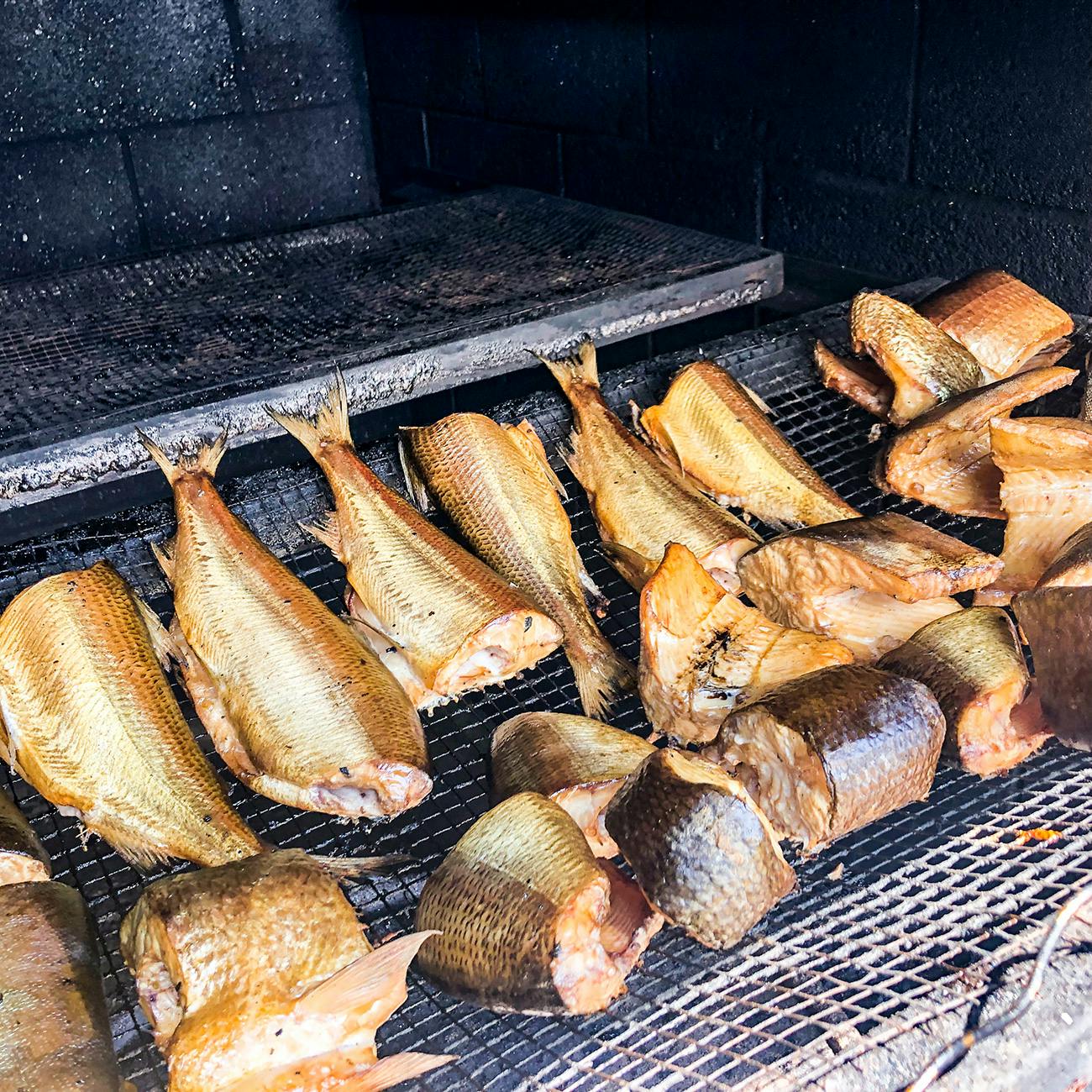
Kathy also explained their process for smoking the fish. The fresh catch is gutted and submerged in a salt and sugar brine for a day, then it’s smoked with maple wood for eight hours in the small concrete-block smokehouse. When she opened the door, the fire was hotter than I’d expected, but maybe they were just trying to finish the cook quickly.
Back out on the car hood, I had a revelation. It was like that first bite of Louie Mueller brisket I had that showed me just how good Texas barbecue could be. It’s hard to describe how much better this smoked fish was than any other I had tried. Maybe it was because it was hot off the smoker, but this fish was decadently moist and fatty, even the leaner whitefish. I don’t think there’s any danger that I quit writing about Texas barbecue to become a smoked fish connoisseur—but if I do, the Fish House will have been the inspiration.

SOUTHEAST MICHIGAN
The rain wouldn’t stop in Ann Arbor, Michigan, as I drove around looking for Ricewood, a barbecue truck specializing in rice bowls. The truck was shut down tight next to a couple reverse-flow smokers loaded with meat in a back parking lot. I figured maybe they closed early due to the weather, or sold out of barbecue, but a Facebook message from them directed me into Morgan & York Fine Wines and Specialty Foods.
The trio of Gabe Golub, his half brother and chef Frank Fejeran, and co-owner Bill Richard parked the popular truck for good and opened an equally popular takeout window within the space in May. The rain may have been the only reason I got my pick of the menu at 1:30 in the afternoon, so I took it as a sign I should try one of everything.
I sat down with Golub, who serves as the pitmaster, as I pulled apart a perfectly smoked slice of his lean brisket. He got a taste for Texas barbecue while stationed with the Army at Fort Hood. He was a regular at Rudy’s, and after he left the Army, his brother asked him to help open Ricewood in 2015. “I fell in love with the barbecue side of it,” Golub said, and in 2017 he traveled to Austin to train with LeRoy & Lewis Barbecue.
Evan LeRoy told me I had to stop at this place, and I wasn’t disappointed. A half pound of brisket comes on top of the rice bowls. It was tender and moist, and would please any Texan. The heavy black pepper was reminiscent of LeRoy’s barbecue, but that’s not the only heat. Raw habaneros are finely diced and spread atop the sliced meat if you ask for your rice bowl to be spicy, which I recommend. Also, get some of the house-made kimchi and quick pickles on the side.


Two scoops of fluffy rice are the base of the bowls. Diced tomatoes and scallions are added, and a soy and vinegar sauce is poured over the top before being crowned with barbecue. Despite the presentation, Golud said, “Our barbecue is pretty predominantly Texas style.” That includes the peppery pork ribs and the pork shoulder, which is served in thick chunks of juicy pork meat with a jet black bark. It was hard to pick a favorite item, but I feel like it’d be hard to find better brisket in Michigan.
I figured Southeast Michigan had delivered its one barbecue surprise of the day—until I got to Dearborn Heights. A.B.’s Amazing Ribs is a halal barbecue joint, serving only smoked beef, that opened in March. That means sausage, brisket, beef back ribs (which were sold out), and the best value of a beef short rib I’ve ever seen. For just $23, a smoked short rib weighing in at more than a pound is served with fries, mac & cheese, and cornbread.
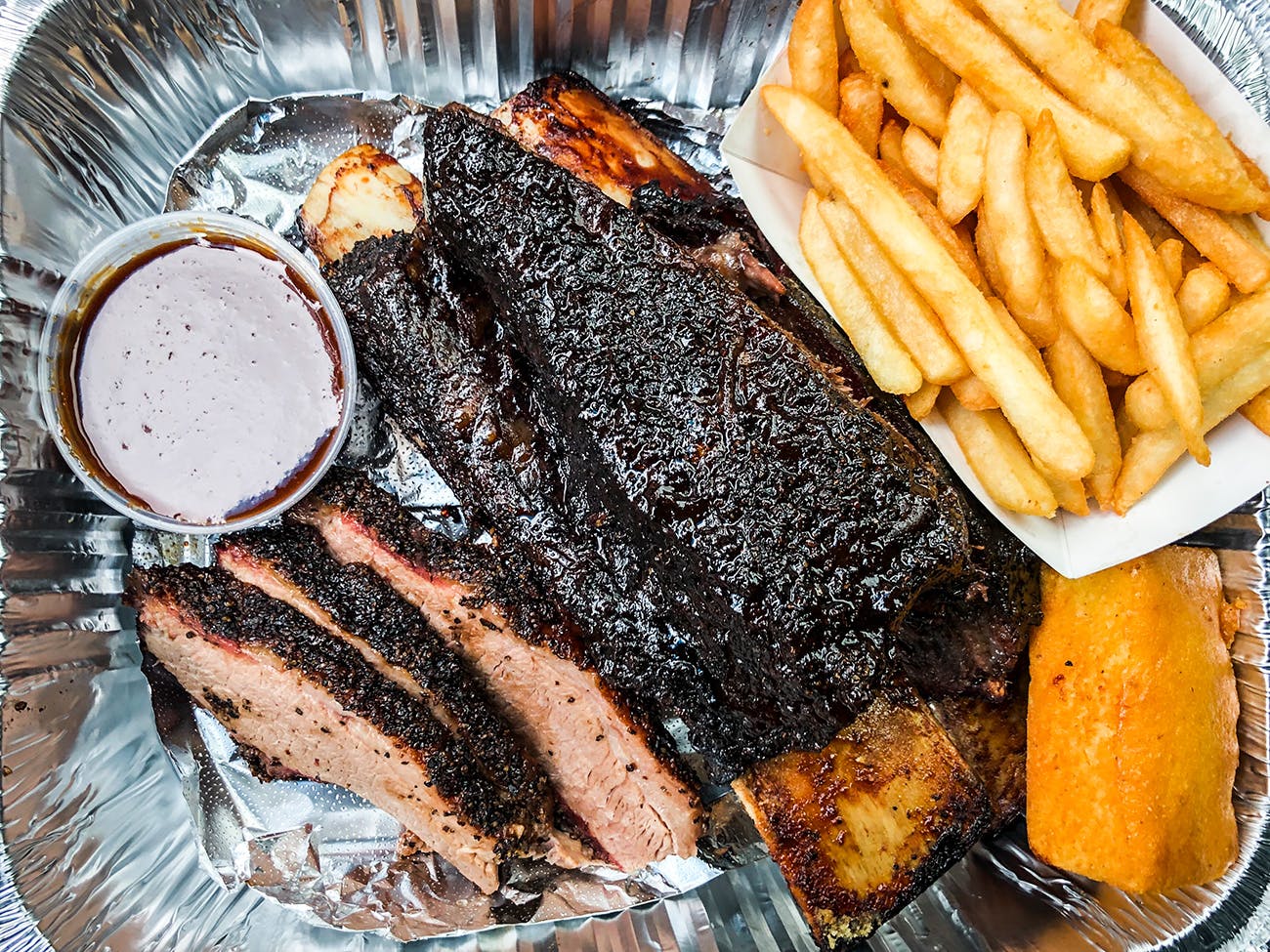
The cutting is all done in the back, and the rib was boxed up in an aluminum foil tray when I paid for it. In my car, I took off the lid and found a beautifully smoked rib glistening with a thin glaze. The texture on it was perfect. I pulled chunks of meat and nicely rendered fat away from the bone and feasted on half a rib before bothering to try anything else. I don’t know how they stay in business with these prices, but folks should be be beating down their door.
After seeing Slows Bar-B-Q down the road in Detroit serve as the de facto representative of the area’s barbecue on so many food shows, I thought it would be the most impressive stop of the day. But even A.B.’s smoky brisket beat out the dry slices they served at Slows. Maybe the new kid in town is a sign of better barbecue to come in Southeast Michigan.
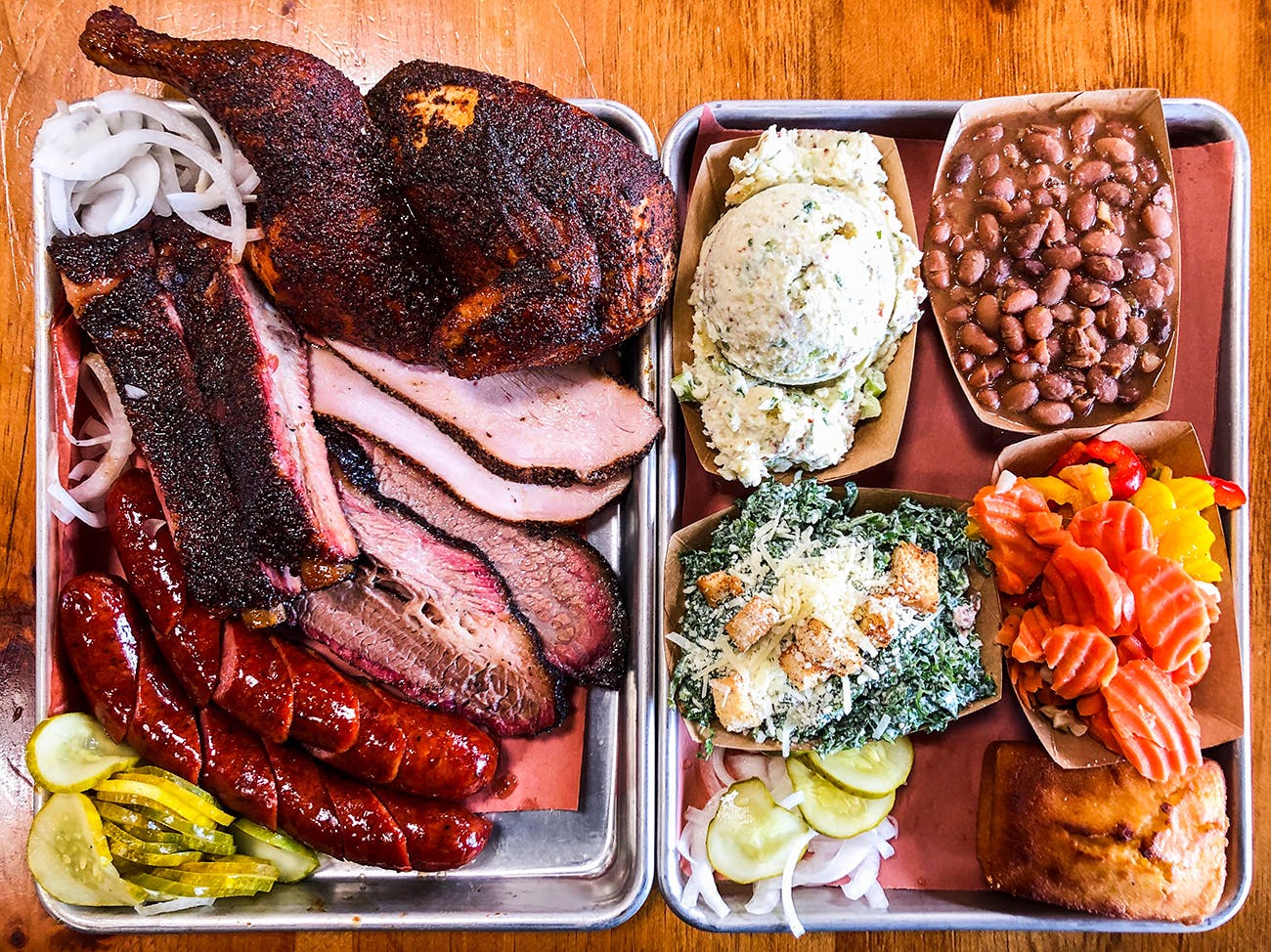
TORONTO
When it seems like every major city in America has at least one great barbecue joint, the largest city in Canada is outdoing many of them with three impressive spots for Texas style barbecue. Adamson Barbecue and Cherry Street Bar-B-Que opened in 2016, and Beach Hill Smokehouse joined them early last year. They’re all cooking with wood, and the Texas staples are well represented.
The smoker of choice for all three joints is the wood-fired Oyler rotisserie made in Mesquite, Texas. It gets cold in Toronto. With temperatures below -30 degrees Celsius (-22 Fahrenheit) in the winter, it can be a challenge to keep a traditional offset smoker hot enough to cook. “Maintaining temps up here is a little different than maintaining temps in Austin,” Lawrence La Pianta told me while I sampled a tray of his barbecue at Cherry Street. He still has two Lang smokers on site in case he needs the capacity.
At Adamson, pitmaster Matt Rushworth was running an offset during my visit as overflow for the 58 briskets he was smoking for the following day. The offsets were outside under a roof, and I commented to owner Adam Skelly that the city of Toronto seemed more tolerant of cooking with wood smokers than the city of Houston. He agreed, but said they were also making room for three more Oyler smokers—on their way from Texas—that would essentially make the offsets in the pit room obsolete.
Adamson’s barbecue is beautiful. Every meat and side seems camera-ready, and the flavor is there as well. Prime briskets from a U.S. supplier are smoked to buttery tenderness. Peppery pork ribs and juicy slices of turkey breast joined a pair of house-made sausages. The snap and smoke were equally good on the garlicky bratwurst and the jalapeño cheese sausage. The stunner was the smoked chicken, which is brined in pickle juice. The chicken takes on a hint of pickles in every bite without tasting like cured meat. At this point in the road trip, I also appreciated the option of a kale salad as a side.


The options are even more plentiful at Cherry Street. You want sweet ribs? They’ve got glazed baby backs. Want them savory? Try the purely Texan pork spare ribs. La Pianta is also using a U.S. supplier, currently Creekstone, for his briskets. He said he takes some gruff for not using Canadian beef and pork, which he finds too lean to make great barbecue.
La Pianta, who used to work in the film business, is well traveled in the barbecue world. His first trip to Lockhart was in 2007. He visited Franklin three years later. Louie Mueller Barbecue is his inspiration for his massive beef rib, while the house-made Italian sausage is a nod to his heritage. Don’t miss the smoky turkey breast or the incredibly juicy chicken either.
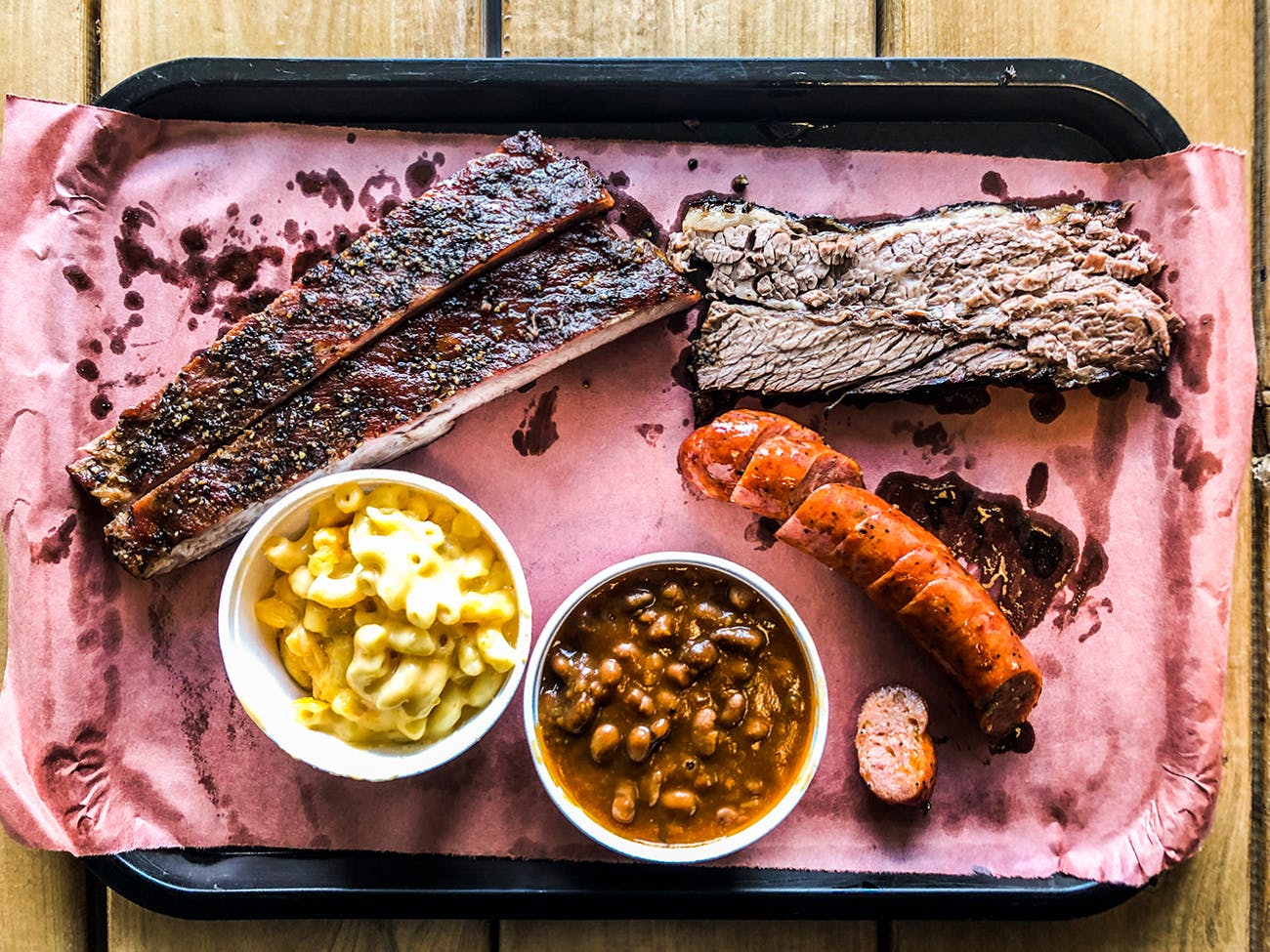
Pitmaster Terrance Hill trained at Lockhart Smokehouse in Dallas before opening Beach Hill Smokehouse with his friend Darien List. Its Central Texas-style barbecue is served way at the back of this slim storefront. I tried the trinity of house-made sausage, smoked brisket, and spare ribs. The brisket was incredibly tender, and I could see the Lockhart influence on the sweet and peppery ribs. But it was at the end of the meal, when I went to retrieve some butcher paper to wrap my leftovers, when I got the best bite. The meat cutter handed me a glistening brisket burnt end covered in bark. It popped with juice as my teeth broke through the outer layer of smoky bark. Ironically, that Kansas City staple is what made the biggest impression here.
Texas barbecue doesn’t seem to be a fad here in Toronto. All three restaurants have received wide praise and would do well even against Texas competition. Cherry Street recently opened a downtown location in a food hall, and Adamson has nearly completed a second location in the Toronto suburb of Aurora. Toronto is a great place for a summer barbecue road trip—but they’re all ready for winter too.
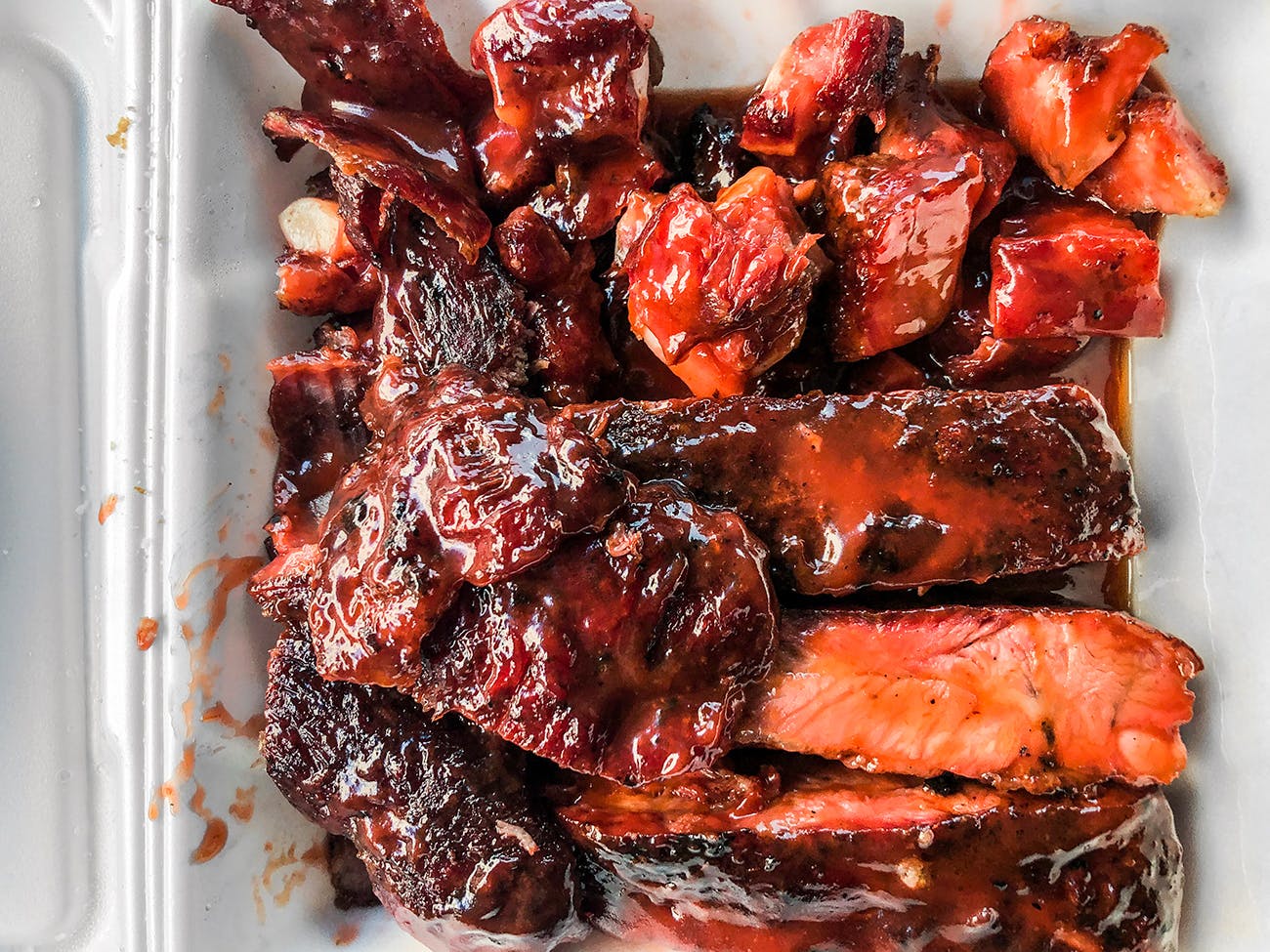
AROUND LAKE MICHIGAN
Indiana, Illinois (outside of Chicago proper), and Wisconsin are states we rarely credit with having an established barbecue culture. They may not be all-in on the new wave big-city barbecue (usually resembling Texas-style), but if we look beyond the “hot” lists, there’s barbecue tradition to be found. In the cities along Lake Michigan, it comes in the form of rib tips.
Rib tips are a cut of pork from the end of the spare ribs. There’s bone and cartilage to work around for bites of the juicy meat. There’s plenty to throw away at the end, but they come in big portions. Some barbecue joints cut the tips from a fully cooked rack of ribs, while others buy the tips as a separate cut with the sternum attached. If spare ribs were considered leftovers from the slaughterhouses of days gone by, rib tips would have just been trash.
Rib tips were, and still are, poor folks’ food. They’re most often found in black-owned barbecue joints. I Google barbecue all over to find places to stop wherever I might be traveling, but I’ve learned on this trip that if you want to find a decades-old barbecue joint in a northern city, search for “rib tips.” The joint will probably be cooking with wood or charcoal, and its sauce recipe is just as important as the tips themselves. If you don’t want sauce, you better tell them, because it’s ladled on generously, usually drenching the fries served alongside (or under) the rib tips. A slice or two of white bread over top makes it a meal.
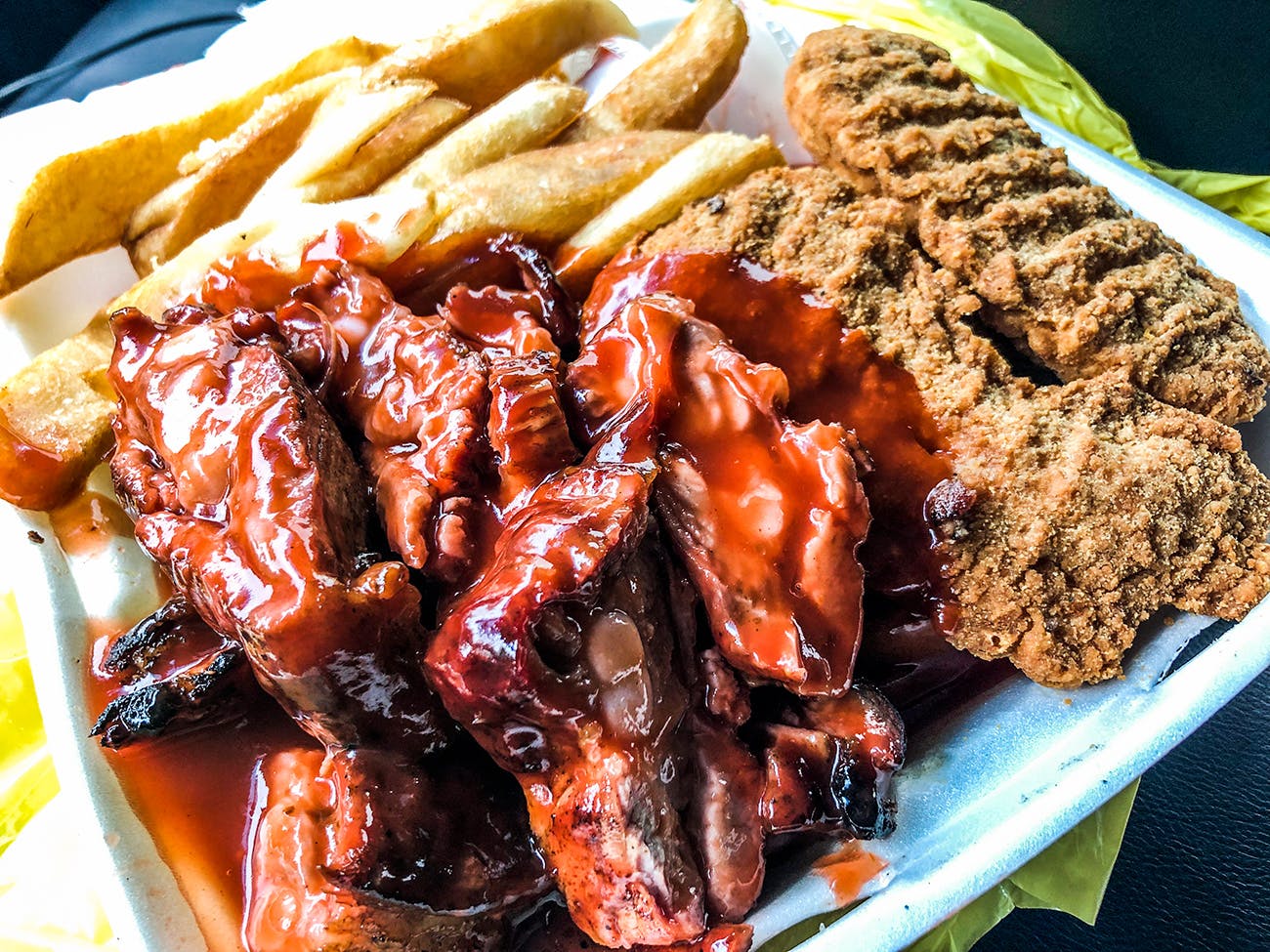
When a rib tip is cooked well, it’s like pork’s version of a burnt end. The fat gets crisp, the seasoning is bold, and the meat is tender. It’s best not to bother with napkins until you’re done eating, lest you waste dozens. Eating them in your car is perilous, as I learned outside Frankie’s BBQ in South Bend, Indiana. Open since 1968, they cook on a large brick pit, the chimney of which greets you by the front door. The sauce is tinted the shade of Catalina salad dressing, but it wipes up off leather seats easily enough. They were out of ribs when I visited. The delivery truck didn’t show, so I got the “chicken sticks,” which turned out to be fried chicken tenders that came straight from the freezer. They were still pretty good in that sauce.
In Gary, Indiana, a newer place has gotten popular serving rib tips and spare ribs. Big Daddy’s BBQ (since 2009) is a massive restaurant inside an otherwise failing strip center. The ribs were some of the best of the trip, and the tips were great with both the mild and the spicy sauce.
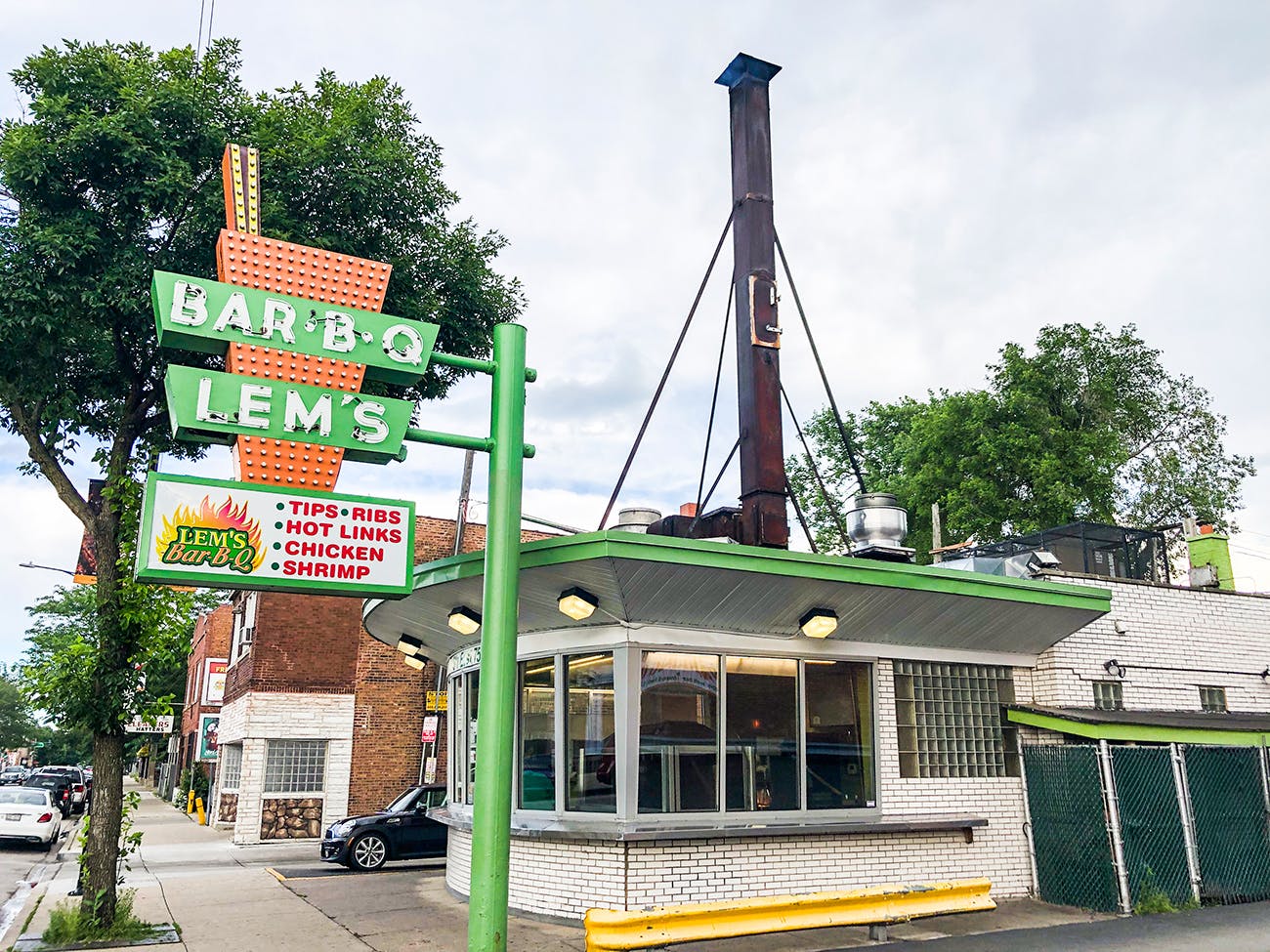
Heading into Chicago, I knew there were too many spots to try. The rib tip and hot link combo is basically Chicago’s version of Texas’s brisket and rib combo plate. Honey I BBQ (since 2005) has always been a favorite, and they didn’t disappoint on this trip. Leon’s (since 1940) and Lem’s Bar-B-Q (since 1954) were must stops. I loved the char on Lem’s rib tips (my favorite of the tour), done over charcoal in their prominently displayed aquarium smoker. This smoker—basically a grill with the top encased in glass and an exhaust hood overtop—is the smoker most often found in Chicago barbecue joints.
They’re running an aquarium smoker at Hillery’s Bar-B-Q in Waukegan, Illinois (1987) too. It got them into some trouble when the place was badly burned during a pit fire in 2016, but they’re running at full tilt now. A man at the cutting block, or more accurately a chopping block, hacked into a thick band of ribs tips with a cleaver, then filled a takeout box for my order. They also had brisket on the menu, though they referred to it as boneless beef ribs. They were out the day I stopped in.
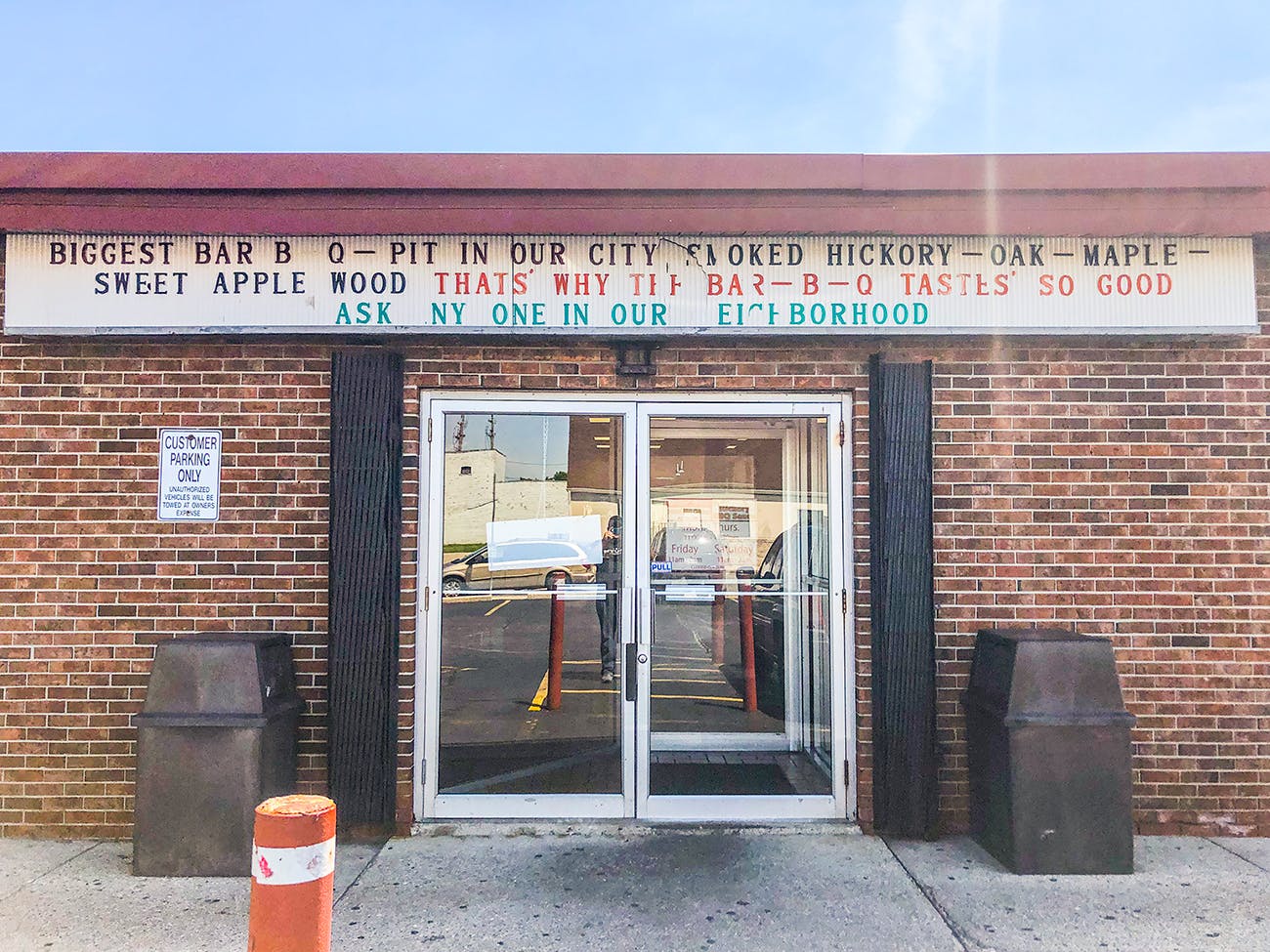
It was in Milwaukee that I tested my theory about Googling “rib tips.” Up popped Speed Queen Bar-B-Q, a joint that’s been serving barbecue since 1957 on the north side of town. A sign out front boasted of the “biggest Bar-B-Q pit in our city,” but they wouldn’t let me have a look. The ribs were better than the tips, but the most curious (and best) item on the menu was the “outside meat.” It’s the outer bark of the pork shoulder, much like “outside brown” meat that can be requested from the pork shoulders in the Piedmont region of North Carolina.
As I sit here writing this in Minneapolis, I searched for rib tips in the city and found a black-owned barbecue joint that’s been cooking them over wood since 1989. My point being, there is a barbecue tradition in cities all over the country. It’s largely ignored, and maybe taken for granted, because it’s not new. And let’s face it, black-owned barbecue joints in the “bad” part of town may not be heralded by the chambers of commerce or food writers. That’s why I was happy to follow Nick Kindelsperger’s Instagram account recently. He writes for the Chicago Tribune and just published a list of his favorite rib tips from an extensive tour of the city. Of course, he published it the day after I left Chicago, and I didn’t get to try his top spot, Trice’s Original Slab Bar-B-Q, but that gives me reason to return. And until I do, I’ll spend as much time searching for rib tips as I do plain old barbecue.

TWIN CITIES
This road trip began with a barbecue dinner in St. Paul at Revival, and we’ll end it back in the Twin Cities with a trip to Animales Barbeque Co. in Minneapolis. Revival made its name on fried chicken when it opened in Minneapolis in 2015, but barbecue became a bigger part of the menu a year later when its St. Paul location was added. Since then, a third location in the Keg & Case food hall ditched fried chicken altogether for a full barbecue menu. I chose the St. Paul location to be able to sample a little of both.
The menu at Revival reads like a Southern restaurant with barbecue mixed in. That means pinto beans, mac and cheese, and cornbread, alongside red rice and peas, cheese grits, and biscuits. Before we get to the barbecue, the cornbread may have been the best I’ve eaten. I know, I know—in Minnesota? The muffin had an outer crust that straddled crunchy and chewy. The interior was pillowy soft. It was just slightly sweet, with some honey butter on the side.
It’s hard to get a straight-up barbecue plate at Revival. A la carte options for brisket, pork shoulder, and pork belly require ordering a half pound. I opted for a half rack of St. Louis ribs with brisket on the side. The ribs had a sweet glaze and were served uncut. I don’t advocate for falling-off-the-bone ribs, but if they’re served in this way, they should be. At Revival, I had to do the knife work myself.


Slices of brisket, served with chunks of pickled watermelon rind plopped on top, were tender enough, but I preferred the bold flavor of the spicy and saucy burnt ends. They arrived in a composed dish with a crunchy and bright slaw of cabbage and bits of snow pea. A black bean tostada covered in refried black beans was hidden beneath, like an afterthought at the bottom of the bowl. Beans were also the base for another bowl on the menu. Technically an appetizer, the pintos and smoked pork belly—tender, smoky, and well-seasoned—could make a meal. It was the best smoked item on the menu.
Smoked pork belly and barbecue bowls were also a feature at Animales. The wait staff and linen napkins of Revival were replaced with a food truck window and plastic ware at Animales. The truck, parked outside Able Brewery in Minneapolis since it opened in late 2018, boasts a wood-fired, reverse-flow smoker on display out front. They use it for beef cheeks, brisket, and beef ribs, none of which were available on the Thursday I visited. Inside the truck, a Southern Pride, like Revival uses, takes care of the ribs and pork bellies.
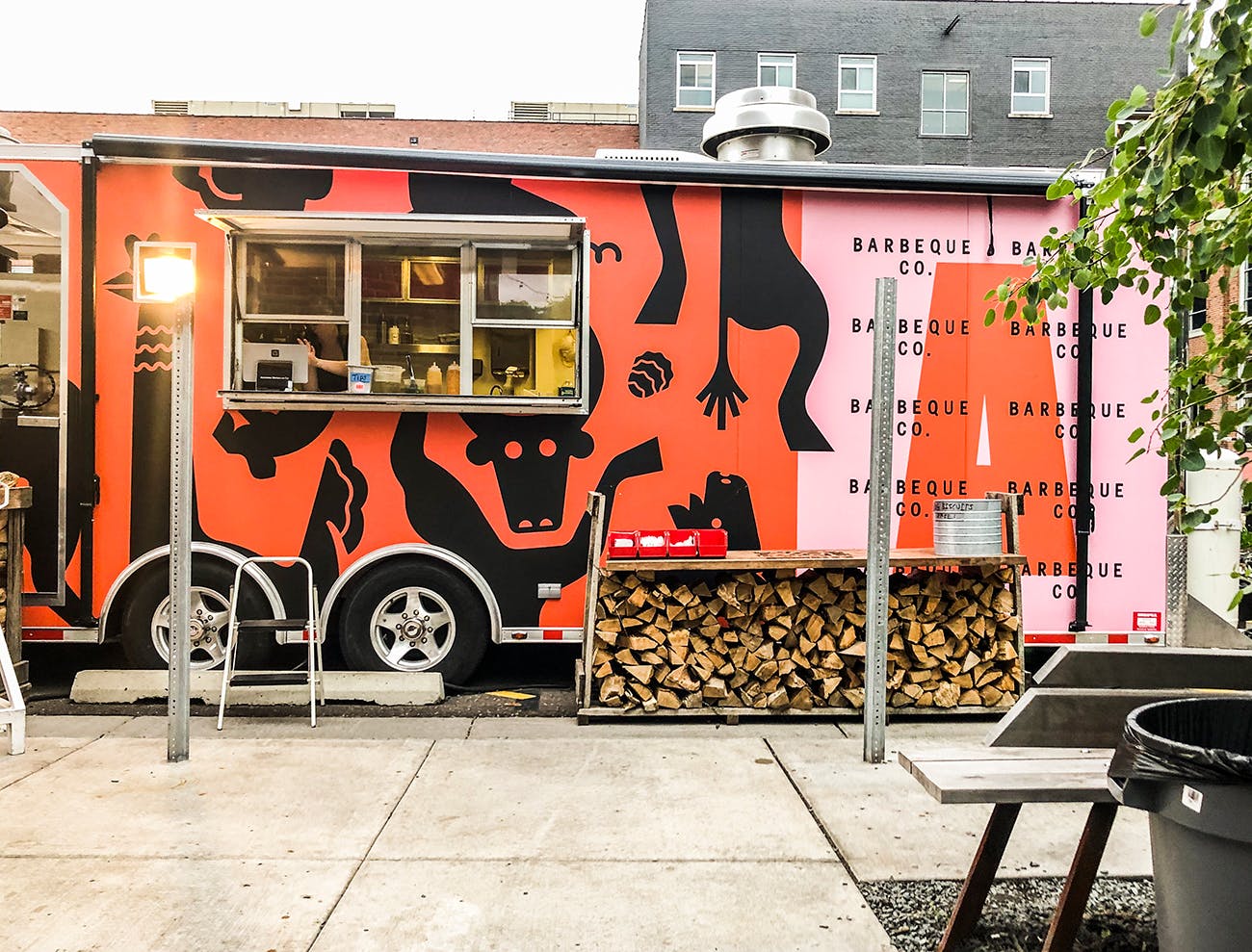
A grain bowl topped with smoked chicken, peanuts, and most everything else from the pantry felt healthy in a bad way. The bean bowl with sausage, pickled onions, and watercress was more like it. Oh, and that sausage—this past weekend it was jalapeño cheese. The links were incredibly juicy, had an excellent snap, and would impress any Texan. I loved the smoked pork belly as well, especially the burnt end portions cubed up on the tray and the sweet mustard sauce they’re served with.
Animales changes its specials weekly, and a look at their Instagram account shows them pushing the boundaries of what we might call traditional barbecue in an area without a barbecue style of its own. Revival is doing some of the same, with the burnt end tostada, and the pork belly bowl. They’re both borrowing from Texas and elsewhere, but it’s not just a facsimile. The Twin Cities have some work to do to create a unique barbecue style, but these two spots together could form a solid foundation.
- More About:
- Black BBQ


